By Peter W. Smorynski
The ground shakes, buildings tremble, and screams of terror mix with shouts of hope. For over sixty years, all around the globe, there’s only been one monster who can elicit such a contradictory phenomenon. GODZILLA.
Recently, I was approached by an acquaintance in academics to comment on how Godzilla affected pop culture, particularly movies, and how Japan’s famous giant monster-turned-antihero came to be such a familiar face in America. What follows is my in-depth response, which couldn’t be timelier as the mighty atomic reptile from the depths is in the midst of yet another bold resurgence. Now, just to get out ahead of this, there is some dispute over what gender Godzilla should be referred to as, if any. But given that Godzilla is called the “King of the Monsters,” for the sake of consistency, I will go with the male pronouns in this article. With that out of the way, let’s answer the call of that distinctive screeching roar.
How did Godzilla affect pop culture?
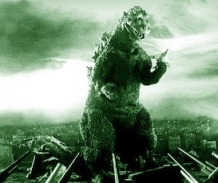 Godzilla has had a complicated but far-reaching effect on pop culture. As originally intended, the first Godzilla film, known as Gojira, was a metaphor for a post-World War II Japan. Its imagery and script were referencing the horrifying aftermath of the atomic bombings of Hiroshima and Nagasaki by the United States, as well as the subsequent presence of the American military and its nuclear weapons tests in the Pacific Ocean. However, the 1954 Gojira by Toho Co., Ltd. was significantly edited and reworked when it premiered overseas in 1956 as Godzilla: King of the Monsters!, and scenes related most closely to the controversial metaphors noted above were either removed or downplayed.
Godzilla has had a complicated but far-reaching effect on pop culture. As originally intended, the first Godzilla film, known as Gojira, was a metaphor for a post-World War II Japan. Its imagery and script were referencing the horrifying aftermath of the atomic bombings of Hiroshima and Nagasaki by the United States, as well as the subsequent presence of the American military and its nuclear weapons tests in the Pacific Ocean. However, the 1954 Gojira by Toho Co., Ltd. was significantly edited and reworked when it premiered overseas in 1956 as Godzilla: King of the Monsters!, and scenes related most closely to the controversial metaphors noted above were either removed or downplayed.
That said, the titular Godzilla is still a creature that emerges from the Pacific Ocean due to the testing of nuclear weapons, and so despite the editing, the film retains some fraction of its original social-political metaphor. During this era of film, there were a number of movies exploring the consequences of nuclear testing on the awakening or creation of massive monsters, including The Beast from 20,000 Fathoms in 1953 and Them! in 1954. As such, Godzilla: King of the Monsters! joined the conversation of pop culture media at the time as a cautionary tale of humans meddling with the natural order through scientific advancements, and thereby suffering the consequences. Subsequent Godzilla films on both sides of the Pacific have at times included subplots related to this idea—sometimes with regard to nuclear energy, other times related to advances in robotics or some other technology—and this has helped to keep these thematic elements strong in pop culture to this day.
But more so than with its social-political themes, Godzilla has had a far more prominent and lasting commercial effect on the world. Perhaps because of the prolific number of sequel movies, perhaps because he clashed with the iconic King Kong in King Kong vs. Godzilla in the early 1960s, or maybe because of his superlative title as the “King of the Monsters,” Godzilla emerged in pop culture around the world as the signature giant monster and a broader metaphor for an overwhelming force of destruction, whether that be natural or man-made. This fact has been parodied in numerous cartoons over the years, including but not limited to The Simpsons, Family Guy, DuckTales, Animaniacs, Pinky and the Brain, Futurama, South Park, and My Little Pony—where, as an aside, the rampaging, often black or gray creature is generally depicted in the green coloration popularized by American marketing.
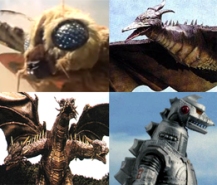 In his sequel films, Godzilla’s power is both feared and respected, as he gradually becomes an antihero by battling off giant monsters, robots, and aliens that threaten all life on Earth. His size and strength are augmented in battle by his “atomic breath” attack, a creatively influential mouth-fired beam sometimes depicted merely as fire but always super powerful. These sequel films either birthed or helped to popularize a whole cast of colorful giant monster characters in pop culture like Mothra, Rodan, King Ghidorah, and Mechagodzilla; collectively, these monsters have appeared in numerous toy lines, cartoons, comics, video games, and various other merchandise alongside Godzilla. Godzilla has even been the subject of songs, such as the 1977 song titled “Godzilla” by Blue Oyster Cult, and similarly used as the name of a French rock band.
In his sequel films, Godzilla’s power is both feared and respected, as he gradually becomes an antihero by battling off giant monsters, robots, and aliens that threaten all life on Earth. His size and strength are augmented in battle by his “atomic breath” attack, a creatively influential mouth-fired beam sometimes depicted merely as fire but always super powerful. These sequel films either birthed or helped to popularize a whole cast of colorful giant monster characters in pop culture like Mothra, Rodan, King Ghidorah, and Mechagodzilla; collectively, these monsters have appeared in numerous toy lines, cartoons, comics, video games, and various other merchandise alongside Godzilla. Godzilla has even been the subject of songs, such as the 1977 song titled “Godzilla” by Blue Oyster Cult, and similarly used as the name of a French rock band.
Even now, Godzilla and/or his fellow franchise monsters are featured in all sorts of odd places, whether it is a controversial Subway restaurant “five-dollar footlong” commercial circa 2008, or a Godzilla and Mothra joke in The Argyle Sweaters comic strip in the Minneapolis Star Tribune on April 26, 2018. Godzilla has left such an indelible cultural impact that he was even given a star on the Hollywood Walk of Fame in 2004 and awarded the title of tourism ambassador for the Shinjuku ward of Tokyo, Japan in 2015. But most stunningly, and as a true testament to his staying power, it was reported in Japan’s The Mainichi newspaper this past May that a professor at Wakayama Shin-ai Women’s Junior College in Wakayama Prefecture was teaching a class on Japan’s constitution via the lens of Godzilla movies; and further, in October, NASA officially named a constellation after the King of the Monsters—putting the tailed ocean beast of cinema in the same league as timeless myths at least as old as 700 BC.
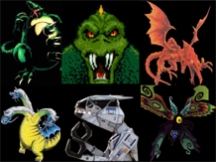 The prevalence of Godzilla and friends in various media and commercial goods has also spawned a lot of look-alikes or homages in all sorts of entertainment venues. Arena events like monster truck rallies are not immune to this, as there is a real-life giant, fire-breathing, car-eating robotic dinosaur attraction dubbed Robosaurus, which was created in 1989 and has been compared to Godzilla at times. It could also be argued that Gleeok, a recurring three-headed dragon from Nintendo’s The Legend of Zelda video game series, has a counterpart in King Ghidorah, and the same could be suggested for Mothula possibly being a reference to Mothra. Likewise, Nintendo’s Metroid series has two antagonists in Kraid and Ridley that bear quite a striking resemblance to Godzilla and Rodan, respectively. It’s not much of a stretch to say that Godzilla and its franchise characters loom large in the world of creative media and are the archetypes of choice for many giant monsters in modern pop culture. A more direct example of this is in the video game series by Midway called Rampage, which began in 1986 and has a number of giant monsters smashing cities, one of whom is named Lizzie—a giant, radioactively produced lizard-monster clearly drawing inspiration from Godzilla.
The prevalence of Godzilla and friends in various media and commercial goods has also spawned a lot of look-alikes or homages in all sorts of entertainment venues. Arena events like monster truck rallies are not immune to this, as there is a real-life giant, fire-breathing, car-eating robotic dinosaur attraction dubbed Robosaurus, which was created in 1989 and has been compared to Godzilla at times. It could also be argued that Gleeok, a recurring three-headed dragon from Nintendo’s The Legend of Zelda video game series, has a counterpart in King Ghidorah, and the same could be suggested for Mothula possibly being a reference to Mothra. Likewise, Nintendo’s Metroid series has two antagonists in Kraid and Ridley that bear quite a striking resemblance to Godzilla and Rodan, respectively. It’s not much of a stretch to say that Godzilla and its franchise characters loom large in the world of creative media and are the archetypes of choice for many giant monsters in modern pop culture. A more direct example of this is in the video game series by Midway called Rampage, which began in 1986 and has a number of giant monsters smashing cities, one of whom is named Lizzie—a giant, radioactively produced lizard-monster clearly drawing inspiration from Godzilla.
Godzilla itself is part of a Japanese genre of film called the “kaiju” genre (which means “strange creature” genre but is often interpreted in English as the “giant monster” genre). A new kind of filming technique involving scale models and actors wearing elaborate rubber suits to create the imitation or illusion of giant monsters, sometimes called “suitmation,” was developed to bring kaiju creatures like Godzilla to life. This genre and its painstaking filming techniques helped give birth to the modern Japanese “tokusatsu” genre, which roughly translates to “special filming” genre.
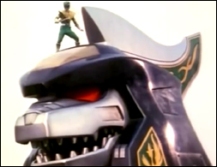 It’s worth noting here that the prolific and popular tokusatsu genre includes the superhero team subgenre known as “Super Sentai,” which is known to feature many giant monsters in the vein of Godzilla. The U.S. franchise called Power Rangers, which was a mega-hit in the 1990s that continues to be produced to this day in all forms of media, is actually an edited reimagining of various Super Sentai series from Japan. This being the case, the set pieces of giant monsters clashing against technology is very much influenced by the Godzilla franchise, and the filming techniques learned from Godzilla movies helped make Power Rangers and its Japanese source material possible. (The Green Ranger’s rising-from-the-ocean Dragonzord in particular is a full-on homage to Godzilla and/or Mechagodzilla.) In other words, the pop culture success of Power Rangers and other tokusatsu-based shows have the pop culture DNA of Godzilla running through them.
It’s worth noting here that the prolific and popular tokusatsu genre includes the superhero team subgenre known as “Super Sentai,” which is known to feature many giant monsters in the vein of Godzilla. The U.S. franchise called Power Rangers, which was a mega-hit in the 1990s that continues to be produced to this day in all forms of media, is actually an edited reimagining of various Super Sentai series from Japan. This being the case, the set pieces of giant monsters clashing against technology is very much influenced by the Godzilla franchise, and the filming techniques learned from Godzilla movies helped make Power Rangers and its Japanese source material possible. (The Green Ranger’s rising-from-the-ocean Dragonzord in particular is a full-on homage to Godzilla and/or Mechagodzilla.) In other words, the pop culture success of Power Rangers and other tokusatsu-based shows have the pop culture DNA of Godzilla running through them.
This creative DNA spread even further, though. As noted earlier, Godzilla and its kaiju genre were in part a reflection of post-World War II anxieties in Japan over the destructive potential and consequences of technology. This has parallels to why the “giant robot” or “mecha” genre emerged in Japan. But rather than giant organic monsters, the mecha genre deals with the destructive potential and consequences of giant humanoid machines, something the Godzilla series later played with in its introduction of the previously mentioned Mechagodzilla character in 1974.
 The reason this needs to be noted is because the two genres, “kaiju” and “mecha,” have produced many crossover series over the years, such as the 1995 anime Neon Genesis Evangelion (reborn as a series of animated films in 2007) or the American-made Pacific Rim film series of the last six years, where giant monsters and giant robots clash. Thus, Godzilla’s DNA is in these pop culture productions as well. Considering the title robot from Tetsujin 28 (known as Gigantor in the U.S.) is considered a forerunner of the mecha genre with its 1956 manga series and 1963 anime adaptation, and only stood around thirty-two feet in height, one has to wonder whether the larger size of some giant robots in the mecha genre as it evolved into things like Neon Genesis Evangelion was also influenced by the imagery of Godzilla. (Regardless, that anime franchise will be crossing over with Godzilla in the upcoming summer of 2019 in a new attraction at the Universal Studios Japan theme park in Osaka, and Godzilla has just recently crossed over with another iconic giant robot series, Gundam, in a November commercial highlighting the two long-running franchises’ latest upcoming films.)
The reason this needs to be noted is because the two genres, “kaiju” and “mecha,” have produced many crossover series over the years, such as the 1995 anime Neon Genesis Evangelion (reborn as a series of animated films in 2007) or the American-made Pacific Rim film series of the last six years, where giant monsters and giant robots clash. Thus, Godzilla’s DNA is in these pop culture productions as well. Considering the title robot from Tetsujin 28 (known as Gigantor in the U.S.) is considered a forerunner of the mecha genre with its 1956 manga series and 1963 anime adaptation, and only stood around thirty-two feet in height, one has to wonder whether the larger size of some giant robots in the mecha genre as it evolved into things like Neon Genesis Evangelion was also influenced by the imagery of Godzilla. (Regardless, that anime franchise will be crossing over with Godzilla in the upcoming summer of 2019 in a new attraction at the Universal Studios Japan theme park in Osaka, and Godzilla has just recently crossed over with another iconic giant robot series, Gundam, in a November commercial highlighting the two long-running franchises’ latest upcoming films.)
All of this considered, while not the sole influence by any means, over time, it could be argued that Godzilla helped to increase interest or curiosity in Japanese cinema, as well as the localization and/or dubbing of Japanese cinema, which then helped bring over other movies and paved the way for Japanese animation to be brought overseas, affecting pop culture even further.
Wait, big movies borrowed from Godzilla?
 Since Godzilla had such a massive impact on pop culture, it follows that many, many movies borrowed from Godzilla, and do so all the time. Any movie with a city-smashing giant creature is likely referencing Godzilla in some way, due to Godzilla’s aforementioned preeminence in the genre. J.J. Abrams’ Cloverfield in 2008 and the recent 2018 adaptation of the formerly noted Rampage video game starring Dwayne “The Rock” Johnson are two such films, while films like 2013’s Pacific Rim and 2018’s Pacific Rim Uprising go a step further by having their “kaiju” monsters emerge from the Pacific Ocean just like Godzilla did so many decades before. The novel-adapted 2018 film Ready Player One by Stephen Spielberg directly lifts a supporting character from the Godzilla franchise, Mechagodzilla. In addition to these, you could make a case that the Jurassic Park and Jurassic World movies are in part a spiritual successor to Godzilla with their human manipulation of nature and subsequent destructive consequences brought about by unleashed reptilian giants. Meanwhile, in Japan, 1965’s Gamera, the Giant Monster was a movie produced by Daiei Motion Picture Company Ltd. to specifically compete with the Godzilla franchise, and it spawned its own franchise of films.
Since Godzilla had such a massive impact on pop culture, it follows that many, many movies borrowed from Godzilla, and do so all the time. Any movie with a city-smashing giant creature is likely referencing Godzilla in some way, due to Godzilla’s aforementioned preeminence in the genre. J.J. Abrams’ Cloverfield in 2008 and the recent 2018 adaptation of the formerly noted Rampage video game starring Dwayne “The Rock” Johnson are two such films, while films like 2013’s Pacific Rim and 2018’s Pacific Rim Uprising go a step further by having their “kaiju” monsters emerge from the Pacific Ocean just like Godzilla did so many decades before. The novel-adapted 2018 film Ready Player One by Stephen Spielberg directly lifts a supporting character from the Godzilla franchise, Mechagodzilla. In addition to these, you could make a case that the Jurassic Park and Jurassic World movies are in part a spiritual successor to Godzilla with their human manipulation of nature and subsequent destructive consequences brought about by unleashed reptilian giants. Meanwhile, in Japan, 1965’s Gamera, the Giant Monster was a movie produced by Daiei Motion Picture Company Ltd. to specifically compete with the Godzilla franchise, and it spawned its own franchise of films.
So how exactly did Godzilla’s popularity grow in America?
Godzilla’s popularity in the U.S. grew from the 1956 Godzilla: King of the Monsters! film, which years after being released in theaters would play in syndication on TV stations all across the United States. Sequel movies—including that 1960s crossover with the iconic King Kong from the popular 1933 film of the same name—along with merchandise, toys, comics, video games, and commercials all played a part in expanding Godzilla’s notoriety and keeping him in the public consciousness. The comics were notably done by companies such as Marvel and Dark Horse, which meant crossovers with American icons like The Avengers in 1979 and future NBA Hall of Famer Charles Barkley in 1993 (based on a 1992 Nike commercial with the same premise). All of the previously discussed parodies and homages in various media have played a part in keeping and spreading Godzilla’s image in the American psyche, too.
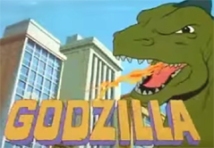 The above may be obvious enough, though what ended up being most important for the Godzilla franchise was that it was continually rebranded for new generations, which meant that it didn’t solely rely on those who had seen the old movies to keep it popular. From 1978 to 1981, there was a new, kid-friendly Godzilla cartoon made by Hanna-Barbera (the creators of The Flintstones, Scooby-Doo, and other famous cartoons). This cartoon would reappear later in the 1990s with new advertising on the popular new cable network Cartoon Network. During this TV run, in 1994, the now defunct Trendmasters toy company released an unrelated yet successful Godzilla toy line, which had TV commercials that aired during popular children’s programming.
The above may be obvious enough, though what ended up being most important for the Godzilla franchise was that it was continually rebranded for new generations, which meant that it didn’t solely rely on those who had seen the old movies to keep it popular. From 1978 to 1981, there was a new, kid-friendly Godzilla cartoon made by Hanna-Barbera (the creators of The Flintstones, Scooby-Doo, and other famous cartoons). This cartoon would reappear later in the 1990s with new advertising on the popular new cable network Cartoon Network. During this TV run, in 1994, the now defunct Trendmasters toy company released an unrelated yet successful Godzilla toy line, which had TV commercials that aired during popular children’s programming.
This helped the big reptilian monster’s case, but it was 1998 that really reinvigorated mainstream interest in Godzilla. In that year, Hollywood, courtesy of Sony Pictures Entertainment’s TriStar division, released the first-ever wholly American Godzilla movie by the makers of the successful 1996 Independence Day film, and this was followed by an all-new cartoon series that ran until 2000. In this wave of interest and marketing fanfare, TriStar also released a 1999 Japanese Godzilla film in U.S. and Canadian theaters in 2000, simply calling it Godzilla 2000. In the end, the monetary and critical results of all this were mixed, but even so it revived the franchise’s notoriety in the U.S.
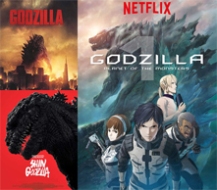 In 2014, another American-produced Godzilla movie was made, this time released by Warner Bros. Pictures but again just called Godzilla. It has two sequels planned: May 2019’s Godzilla: King of the Monsters and May 2020’s Godzilla vs. Kong. These movies look to reintroduce and/or continue the presence of many of Godzilla’s monstrous cinematic co-stars to U.S. audiences. In the meantime, in 2016, Shin Godzilla, the newest live-action Japanese-made Godzilla film to date—by the director of Neon Genesis Evangelion, no less—became the first native Godzilla film since the aforementioned Godzilla 2000 to get a U.S. theatrical release, albeit in a limited-release format.
In 2014, another American-produced Godzilla movie was made, this time released by Warner Bros. Pictures but again just called Godzilla. It has two sequels planned: May 2019’s Godzilla: King of the Monsters and May 2020’s Godzilla vs. Kong. These movies look to reintroduce and/or continue the presence of many of Godzilla’s monstrous cinematic co-stars to U.S. audiences. In the meantime, in 2016, Shin Godzilla, the newest live-action Japanese-made Godzilla film to date—by the director of Neon Genesis Evangelion, no less—became the first native Godzilla film since the aforementioned Godzilla 2000 to get a U.S. theatrical release, albeit in a limited-release format.
While the newest Hollywood Godzilla is being prepped for release next year, a new 3D CG-animated 2017 Godzilla film from Japan was released in association with Netflix called Godzilla: Planet of the Monsters. It was made by the same animation studio behind Knights of Sidonia and Blame! on Netflix, and the recently launched Star Wars: Resistance on Disney Channel. A sequel, Godzilla: City on the Edge of Battle, was released worldwide in July this year. One more film in this series, Godzilla: The Planet Eater, is due November 9, and it seems it will involve King Ghidorah. Given that this new Japanese series of CG movies is distributed by the uber-popular Netflix platform in the United States, it goes without saying that Godzilla is being exposed in a whole new way to American audiences, both old and new. And with those two Hollywood movies and a related prequel graphic novel called Godzilla: Aftershock still to come, it’s safe to assume that not only will Godzilla stay relevant in the U.S. into the next decade, but the seeds have been planted for yet another revival down the road.
Godzilla’s Past and our Future
Godzilla’s quaking footsteps and swaying tail may have knocked over buildings on the big screen, but they also caused a domino effect in pop culture in the U.S. and across the world that continues to this very day. For every small wave affected by his tremors, there was a multiplied result that we often never even think about. For example, that speculated ripple effect on helping to get Japanese cinema and therefore anime localized changed today’s Hollywood. The approach to visuals and choreography from Japanese animation has had a significant impact over the last nineteen years on effects-heavy Hollywood movies, starting at least as early as The Matrix and continuing to this day in the superheroic feats of Marvel movies like Avengers: Infinity War. But that’s not the end of it. Eerily…in an era where special effects rule the box office at an all-time high, and where concerns over renewed nuclear proliferation, environmental crises, and controversial science-fiction-like technology coming true are brewing in the minds of citizens and leaders around the globe, the old King of the Monsters may be more relevant than ever before. Watch out for that next footstep…